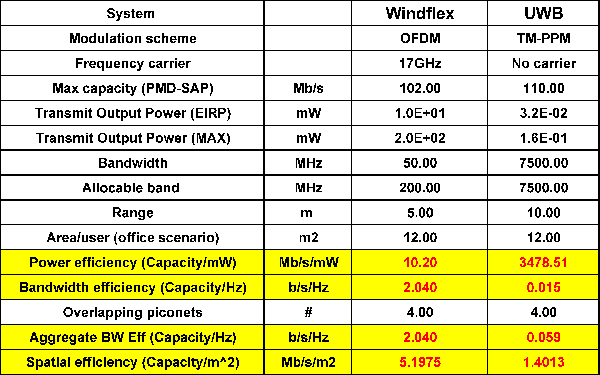

|
Wireless CommunicationChapter: Network Concepts and
Standards
|
Alternative technologies

WIND-FLEX system aims at solving the future capacity demand for high bit rate and high capacity per user in the short range and can therefore be proposed as the solution for next generation wireless personal area networking. Other technologies targeting the same performances objectives are either making use of much wider bandwidth in the low frequency regions (i.e. Ultra Wide Band (UWB)) or at even higher frequencies (i.e. 60 GHz). As far as benchmarking with UWB is concerned, results of preliminary theoretical comparisons between the two technologies are reported in the table herewith.
By that it can be inferred that the two technologies offer similar performances in terms of maximum capacity and spatial efficiency though, because of their intrinsic nature, providing very different figures in terms of power efficiency (much higher for UWB) and spectral efficiency (much higher for WIND-FLEX).
Given the comparable global systems performances, the WIND-FLEX technology offers the added values of keeping backward compatibility with all OFDM systems (where due to significant investments made so far there is considerable know-how), of not requiring significant design challenges on the RF design (as in UWB), of not producing any harmful interferences on other existing technologies, due to the limited portion of unoccupied spectrum used.
As far as the benchmarking with 60 GHz technologies are concerned, the main reason to explore this bandwidth for high bit rate (fixed) wireless access technologies was driven by the high attenuation produced by the oxygen absorption in that range, considered an enabler for easier and more dense frequency reuse. In an indoor environment those propagation characteristics are not exploited being propagation actually limited by obstruction (i.e. walls), moreover the 60GHz propagation require full LOS, not suitable for mobile/nomadic purposes. Another obvious consideration is the much higher RF/IF front-end cost that doesn't make this technology suitable for low cost/consumer applications.
Status and next steps
The WIND-FLEX technology, thanks to combination of high data rate, high spatial efficiency, flexible design and dynamic adaptivity and reconfigurability features at all layers represents one amongst the most attracting candidate option for next generation short-range wireless networking standardization.
A WIND-FLEX proof-of-concept demonstrator is under development and, by Q103 will integrate significant part of WIND-FLEX specifications. A first prototype of the WIND-FLEX demonstrator will be available by end of Q202 and will be shown at Philips Corporate Research Exhibition (Eindhoven, The Netherlands, May02) and at IST Summit on Mobile Communications (Thessaloniki, Greece, Jun02).
The WIND-FLEX consortium, due to its current technological competitive advantage, is open to look for most suitable business ownerships and industry support, in order to identify accordingly most profitable business exploitation path and get proper critical mass to address and solve regulatory and standardization issues.
References
Acknowledgements and contacts
WIND-FLEX is a consortium constituted by industrial and academic companies partly funded by European Commission. This material integrates contributions from all members of WIND-FLEX team. WIND-FLEX project and technology primary contacts are: